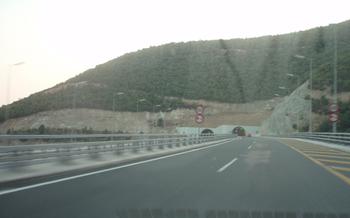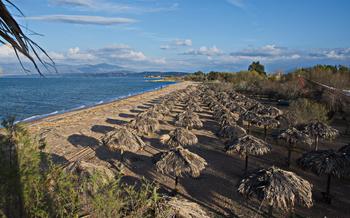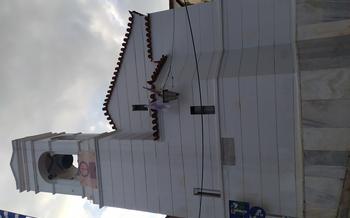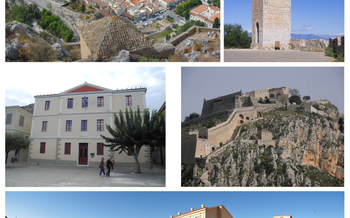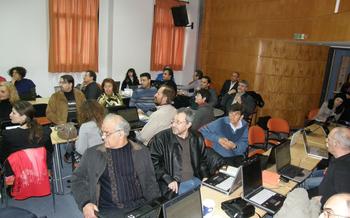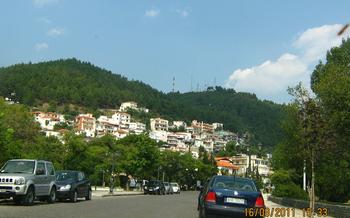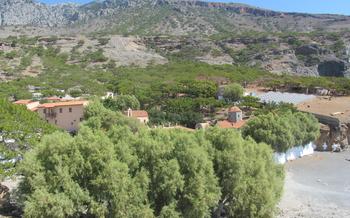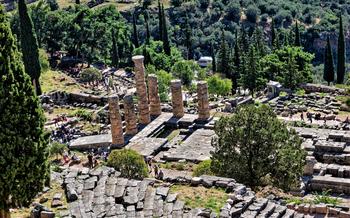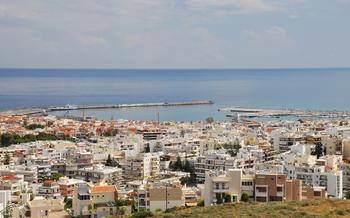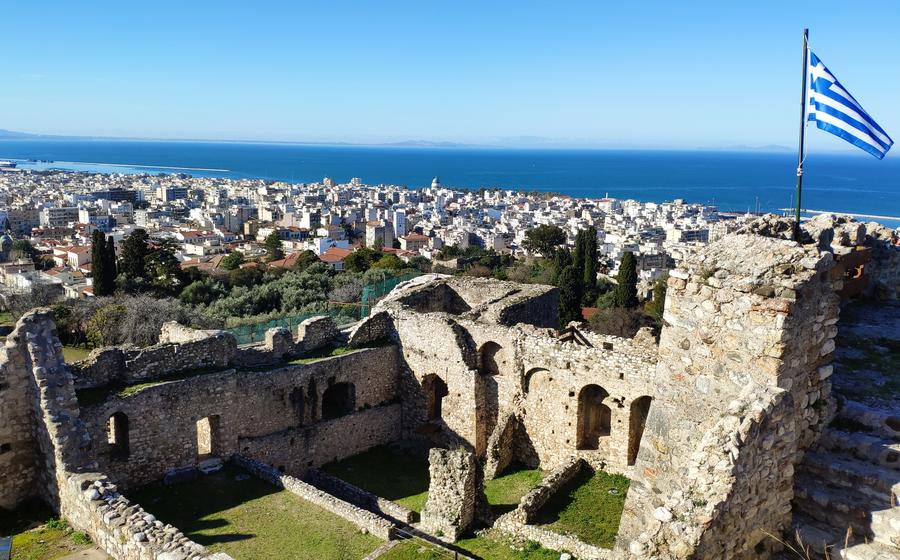
The Medieval Monastery of Agia Lavra
- History of the Monastery
- Religious Importance
- Architecture and Design
- Museum and Exhibits
- Monastic Life
- Natural Surroundings
- Pilgrimage and Retreats
- Local Traditions
- Visitor Etiquette
- Photography and Videography
- Accessibility and Facilities
- Nearby Attractions:
- Accommodations and Dining
- Insider Tip: The Secret Garden
History of the Monastery
Nestled amidst the rolling hills of Peloponnese, Greece, lies the historic and revered Agia Lavra Monastery, a testament to the deep religious and cultural heritage of the region. Founded in the 10th century, the monastery holds a significant place in Greek Orthodox history, serving as a spiritual center and a beacon of faith for centuries.
During the Ottoman occupation of Greece, Agia Lavra emerged as a symbol of resistance and played a pivotal role in the Greek War of Independence. In 1821, the monastery's abbot, Germanos III, raised the flag of rebellion against the Ottoman rule, igniting the flames of the Greek Revolution. This courageous act marked the beginning of a long and arduous struggle for independence, which ultimately led to the liberation of Greece in 182
Architecturally, Agia Lavra is a stunning example of Byzantine and Venetian influences, blending elements from both cultures to create a unique and harmonious style. The monastery complex comprises several structures, including the main church, the bell tower, and the living quarters of the monks. Its intricate stone carvings, colorful frescoes, and elegant arches reflect the artistic and cultural achievements of its time.
Religious Importance
The Medieval Monastery of Agia Lavra holds immense religious significance as a spiritual center for the Greek Orthodox Church. It serves as a place of pilgrimage for Orthodox Christians who seek spiritual renewal and a deeper connection with their faith. The monastery is dedicated to Saint Athanasios the Athonite, who is revered as its patron saint. Every year, on July 2, the monastery celebrates the feast day of Saint Athanasios with a grand festival that attracts pilgrims from all over Greece and beyond. The festival is marked by special religious ceremonies, processions, and traditional festivities. Throughout the year, the monastery hosts various religious rituals, including daily prayers, chanting, and divine liturgies. Visitors can witness these ceremonies and experience the rich spiritual traditions of the Greek Orthodox Church firsthand.
Architecture and Design
The architectural style of Agia Lavra Monastery is a blend of Byzantine and Venetian influences, reflecting the rich history of the region. The main church, known as the Katholikon, is a magnificent example of Byzantine architecture, with its domed roof, intricate mosaics, and colorful frescoes. The bell tower, on the other hand, showcases Venetian influence with its tall, slender structure and arched windows.
Within the monastery complex, visitors can explore various structures, including the living quarters of the monks, the refectory, and the library. The buildings are constructed using traditional materials such as stone and wood, creating a harmonious and rustic ambiance. The courtyards, adorned with cypress trees and blooming flowers, provide a tranquil and serene atmosphere.
Notable architectural features include the impressive arched gateways, intricate stone carvings, and decorative frescoes that adorn the walls of the monastery. These elements add to the overall beauty and grandeur of the complex, making it a true architectural masterpiece.
Museum and Exhibits
Within the confines of the venerable Agia Lavra Monastery lies a treasure trove of religious artifacts, historical relics, and exquisite artwork showcased in a captivating museum. This repository of sacred and cultural heritage invites visitors to embark on a journey through time, immersing themselves in the rich tapestry of Orthodoxy.
Among the museum's prized possessions are a collection of resplendent icons, each a testament to the artistry and devotion of Byzantine and post-Byzantine masters. These sacred images, adorned with gold leaf and vibrant hues, depict holy figures and scenes from the Bible, radiating a sense of divine presence.
In addition to the icons, the museum houses an array of ecclesiastical objects, including intricately carved crosses, chalices, and censers, each imbued with symbolic meaning and historical significance. These artifacts provide a glimpse into the rituals and practices of the Orthodox Church, offering visitors a deeper understanding of its traditions.
Manuscripts, with their delicate calligraphy and intricate illuminations, hold a prominent place within the museum's collection. These precious documents, penned by monks and scribes over the centuries, contain invaluable texts, ranging from theological treatises to historical chronicles. They serve as a testament to the monastery's role as a center of learning and scholarship.
The museum's exhibits are not merely a collection of artifacts but a narrative of faith, history, and artistic expression. They offer visitors an opportunity to delve into the heart of the Orthodox tradition, gaining insights into the beliefs, practices, and cultural heritage of the Greek people.
Monastic Life
Within the walls of Agia Lavra, a dedicated community of monks leads a life of devotion and service. Their daily routine revolves around prayer, work, and communal living, guided by the teachings of the Eastern Orthodox Church. Central to their practice is the Divine Liturgy, a solemn ceremony held each morning in the monastery's grand church. The monks gather in unison, their voices harmonizing in sacred hymns, as they partake in the sacrament of Holy Communion.
Beyond their spiritual obligations, the monks engage in various tasks to sustain the monastery and contribute to the community. They tend to the surrounding gardens, cultivating fresh produce for their daily meals. In the monastery's workshop, they craft intricate woodwork and religious artifacts, demonstrating their skills in traditional craftsmanship. Some monks are involved in scholarly pursuits, studying ancient texts and contributing to the preservation of Orthodox theology.
The monastery's commitment to community extends beyond its walls. The monks actively engage with pilgrims and visitors, providing guidance, spiritual counseling, and a listening ear to those seeking solace and support. Through their selfless service and unwavering dedication, the monks of Agia Lavra embody the essence of monasticism, perpetuating a centuries-old tradition of faith and devotion.
Natural Surroundings
The Medieval Monastery of Agia Lavra is nestled amidst a picturesque landscape, surrounded by lush greenery and rolling hills. Its idyllic location offers visitors a chance to immerse themselves in the beauty of nature while exploring this sacred site. The monastery's proximity to the Gulf of Patras provides stunning views of the sparkling blue waters and the distant coastline.
Nature enthusiasts will delight in the opportunity to embark on nature walks or hiking trails in the surrounding area, exploring the diverse flora and fauna that call this region home. The serene atmosphere and tranquil surroundings make Agia Lavra an ideal destination for those seeking a peaceful retreat amidst the wonders of nature.
Pilgrimage and Retreats
The Medieval Monastery of Agia Lavra holds immense significance as a destination for Orthodox pilgrims seeking spiritual renewal and enlightenment. Pilgrims from various parts of Greece and beyond flock to the monastery to immerse themselves in its sacred atmosphere and seek guidance from the resident monks. Visitors can embark on guided tours led by knowledgeable monks, who share insights into the monastery's history, traditions, and spiritual significance. Retreats and workshops are also organized periodically, providing visitors with an opportunity to delve deeper into monasticism, engage in contemplative practices, and connect with their inner selves. Through these experiences, pilgrims can find solace, peace, and a sense of spiritual fulfillment at the Monastery of Agia Lavra.
Local Traditions
The Medieval Monastery of Agia Lavra is deeply intertwined with the local traditions and customs of the region. Each year, the monastery plays a central role in several unique celebrations and festivals that draw visitors from near and far. One of the most notable events is the annual feast day of Saint Athanasios the Athonite, the monastery's patron saint, which takes place on July 5th. During this festival, the monastery hosts a grand celebration that includes a procession carrying the saint's relics, traditional Greek music and dancing, and a feast shared by the monks and visitors alike.
Another significant tradition associated with Agia Lavra is the lighting of the "lampada," an oil lamp that is said to have been burning continuously since the monastery's foundation. This lamp is a symbol of the monastery's enduring faith and is believed to possess miraculous powers. Many pilgrims visit the monastery to witness the lampada and seek blessings from its sacred light.
These local traditions and festivals play a vital role in preserving the cultural heritage of the region and showcasing the vibrant faith and customs of the Greek Orthodox community. Visitors to Agia Lavra during these special occasions have the opportunity to immerse themselves in the local culture, witness unique rituals, and gain a deeper understanding of the monastery's significance beyond its historical and religious importance.
Visitor Etiquette
When visiting Agia Lavra Monastery, it is important to observe proper etiquette and conduct to show respect for the monks and the sacredness of the site. Here are some guidelines to keep in mind:
-
Dress code: Visitors should dress modestly and appropriately, avoiding revealing or overly casual clothing. It is customary for women to cover their heads with a scarf or shawl when entering the church.
-
Noise level: Maintain a respectful silence within the monastery grounds, especially during religious services or when in the vicinity of monks' cells.
-
Photography and videography: Photography and videography are generally permitted within the monastery complex, but it is essential to ask for permission before capturing images or videos of individuals or religious ceremonies.
-
Respect for monks: Monks should be addressed with respect and formality. It is customary to greet them with the traditional Greek Orthodox greeting, "Χριστός Ανέστη" ("Christ is Risen"), and respond with "Αληθώς Ανέστη" ("Truly He is Risen").
-
Smoking and alcohol: Smoking and alcohol consumption are not permitted within the monastery grounds.
-
Respect for the environment: Visitors should avoid littering and dispose of their waste responsibly.
By following these guidelines, visitors can ensure that they have a respectful and enriching experience at Agia Lavra Monastery.
Photography and Videography
Photography and videography are generally permitted within the monastery complex, allowing visitors to capture the beauty and significance of this historic site. However, it is essential to respect the sanctity of the monastery and the privacy of its inhabitants. Refrain from using flash photography or filming during religious services or in areas designated for private use. Always seek permission before photographing or filming individuals, especially monks or pilgrims engaged in prayer or contemplation. By following these guidelines, visitors can document their experiences while respecting the spiritual nature of Agia Lavra.
Accessibility and Facilities
Agia Lavra Monastery is committed to providing a welcoming and accessible environment for all visitors. The monastery grounds are wheelchair accessible, with designated parking areas available for visitors with disabilities. Restrooms, drinking water, and basic amenities are also available within the complex. For those seeking further information or guidance, there is a visitor center located just inside the main entrance, where friendly and knowledgeable staff are ready to assist.
Nearby Attractions:
In addition to the historical and religious significance of the Agia Lavra Monastery, the surrounding area offers a wealth of other attractions for visitors to explore. Just a short drive from the monastery, you can visit the ancient city of Patras, with its well-preserved Roman ruins and bustling modern center. For a glimpse into the region's natural beauty, head to the nearby Achaia Clauss winery, set amidst picturesque vineyards and offering stunning views of the Gulf of Patras. Take a leisurely stroll along the scenic coastal path, enjoying the fresh sea breeze and panoramic vistas. Consider combining your visit to Agia Lavra with a trip to the ancient site of Olympia, birthplace of the Olympic Games, or explore the enchanting mountain villages of the Peloponnese region, each with its unique charm and traditions. With so much to see and experience in the vicinity, allow ample time to fully immerse yourself in the cultural and natural wonders of this captivating region.
Accommodations and Dining
For a truly immersive experience, consider staying overnight near the monastery. Several charming hotels and guesthouses in the area offer cozy accommodations and breathtaking views of the surrounding landscape. Indulge in traditional Greek cuisine at local tavernas, where you can savor mouthwatering dishes prepared with fresh, local ingredients. Be sure to try specialties like grilled octopus, moussaka, and baklava. For budget-conscious travelers, there are affordable options available, allowing you to enjoy a comfortable and authentic Greek experience without breaking the bank.
Insider Tip: The Secret Garden
Venture beyond the main courtyard of Agia Lavra, and you'll discover a hidden gem: a secluded garden known only to a few. Nestled amidst towering cypress trees and fragrant jasmine bushes, this tranquil oasis offers a moment of serenity away from the bustle of the monastery. Adorned with colorful flowers, a trickling fountain, and intricate stone pathways, the secret garden is a testament to the beauty and tranquility that can be found within the monastery walls. Take a moment to pause, reflect, and soak in the peaceful atmosphere of this hidden sanctuary.
